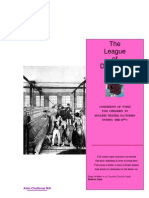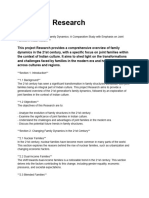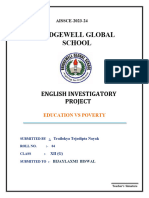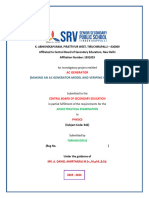Everyday Life of Slum Children: A Case Study From Education Perspective
Everyday Life of Slum Children: A Case Study From Education Perspective
Uploaded by
TanishkaCopyright:
Available Formats
Everyday Life of Slum Children: A Case Study From Education Perspective
Everyday Life of Slum Children: A Case Study From Education Perspective
Uploaded by
TanishkaOriginal Title
Copyright
Available Formats
Share this document
Did you find this document useful?
Is this content inappropriate?
Copyright:
Available Formats
Everyday Life of Slum Children: A Case Study From Education Perspective
Everyday Life of Slum Children: A Case Study From Education Perspective
Uploaded by
TanishkaCopyright:
Available Formats
Everyday Life of Slum Children: A Case Study from Education Perspective
Aditi Deshpande1
1
Symbiosis Institute of Design, Symbiosis International (Deemed University) Pune, Maharashtra, India.
1
aditi.deshpande@sid.edu.in
Abstract
Every year, the city of Pune attracts migrant workers due to urbanization, and these migrants form
residential pockets called slums. Today, around 40% of Pune's population lives in urban slums,
around 11% of children, who have little or no access to education with the everyday hand-to-mouth
struggle for survival. This study explores the lives of slum children and their educational conditions.
Three case studies were conducted with three slums from uptown areas of Pune. Focus group
discussions, interviews, and visual survey methods were employed, leading to qualitative analysis.
Analysis threw light on the everyday challenges faced by slum children in accessing education. The
visual studies imply the need for architectural intervention. The findings also suggest policy
implications towards the provision of education towards the betterment of the lives of slum children.
Working and learning are the two social processes; without breaking the legal structures on child
labor, children working within the home as domestic labor or in the household enterprise is a
common occurrence in urban centers, particularly among those who are household income is derived
from the informal sector and who have lower income levels. Working modes and times differ
depending on the situation. Owing to the size of India's informal economy and attempts to reduce
child labor trafficking, a strong emphasis has been placed on developing and implementing social
policies that address child labor.
Key-words: Slum Children, Education, Learning Center, Case Study, Working and Learning.
1. Introduction
Pune is the second-largest city in the state of Maharashtra, after Mumbai. It is a tier 2 city and
home for large industrial and educational organizations. 40% of its population lives in the slums. The
migrants contribute most of this urban slum population from rural areas of Maharashtra and other
neighboring states moving to the city searching for work and better living conditions [2]. The most
vulnerable section of these slums is children. These children are deprived of basic living conditions
ISSN: 2237-0722 5191
Vol. 11 No. 4 (2021)
Received: 26.07.2021 – Accepted: 30.08.2021
and education. Surrounded by poverty, illness, and despair, they fight for their survival daily [3].
Most of these children are not enrolled in local schools and have limited access to books and a place
to study. The children who are enrolled in the schools still lack basic knowledge due to ignorance of
the education system. Several initiatives led by the Government of India like Sarva Shiksha Abhiyan,
Right to Education Act [6] are a few of the efforts to provide universal education to children aged 6 to
14. Although many studies conducted into the living conditions and lack of basic infrastructure in
slums from an architectural point of view, the condition of education of slum children is less
explored. This study was conducted as part of the design research for mobile schools for slum
children. The study had three objectives:
1. To study how the slum children are accessing education.
2. To understand the everyday life issues faced by slum children with regards to education.
3. To understand the space utilization pattern for learning activities.
2. Background
A slum household is a group of individuals living under the same roof in an urban area who
lack one or more of the following: inadequate access to safe water, poor structural quality of housing,
insecurity, inadequate access to sanitation and infrastructure [1].
A Slum, for Census, has been defined as residential areas where dwellings are unfit for human
habitation by reasons of dilapidation, overcrowding, faulty arrangements and design of such
buildings, narrowness or faulty arrangement of the street, lack of ventilation, light, or sanitation
facilities or any combination of these factors, which are detrimental to the safety and health [2].
According to Pune census data, 10.79% of the child population lives in slums, and the literacy
rate among these children is 81.73%. Moreover, out of every 100 children, only 32 children finish
their age-appropriate school education [4]. Among the major factors affecting the education of slum
children are poverty, lack of educational facilities, space constraints in slums, migration of parents,
and child labor [10].
3. Research Methods and Sampling
For this research, a Case Study methodology was employed [11]. This research comprised
three cases of slums from the uptown areas of Koregaon Park (slum 1), Kalyani Nagar (slum 2), and
ISSN: 2237-0722 5192
Vol. 11 No. 4 (2021)
Received: 26.07.2021 – Accepted: 30.08.2021
Sakore Nagar (slum 3) in Pune city. The data was collected from Focus group discussions, one to
group interviews, one-one interviews, and a visual survey of the slums [12].
Focus group discussions were conducted with three groups in each slum with 6, 6, and 5 slum
dwellers (age between 19-45 years, median age 32). One to group interviews was conducted with
three groups at each slum comprising 15, 10, and 10 children respectively (age between 5-10 years,
median age 9). In-depth one to one interview were conducted with 3 (age 5, 9 &12, 2 (age 7 & 10)
and 2 (age 8 & 10) children respectively from site1, 2 and 3. Also, in-depth interviews with (key
informant (teacher from NGO, age 32) was conducted. Slum Demographics of Children in NGO
Learning Center are indicated in Table 1.
Table 1 - Slum Demographics of Children in NGO Learning Center
Slum Age group (Yrs) Number of children Age group (yrs) Number of children Total
1 2-5 16 6-12 36 52
2 2-5 25 6-12 17 42
3 2-5 05 6-14 26 31
Source: Identity Foundation NGO
4. Data Collection
Primary data was collected at each slum over weekdays and weekends to understand the
children's routine. The interviews were informal and open-ended and were conducted in local
languages - Marathi and Hindi. The study was conducted in January 2019 over two weeks.
Figure 1 - Location of Slums
Source: Google earth image
ISSN: 2237-0722 5193
Vol. 11 No. 4 (2021)
Received: 26.07.2021 – Accepted: 30.08.2021
The interviews were conducted with the help of Idea foundation and Identity Foundation,
NGOs Working in these slums with the children. The children and their parents were briefed about
the project in the first week, and consent was obtained from the NGO. In the first week, a visual
survey of the slum was conducted, followed by focus group discussions and interviews [14]. Location
of Slums, Source: Google Earth Image as indicated in Figure 1. After the interviews, again, one more
visual survey was conducted. The obtained data were used for open coding. They were mapped with
the visual survey to gain insights into the spatial patterns.
5. Results and Discussion
For analysis of interviews, open coding was done. Table 2 shows different information
patterns that emerged in the studies in all three slums.
Table 2 - Comparative Analysis
Codes Slum 1 Slum 2 Slum 3
Going to government Going to government schools.
Enrolled in village schools.
schools. Use NGO bus to travel to
Use NGO bus to travel to
Access to Use NGO bus to school.
school.
education travel to school. Only young children attend
Attend classes run by NGOs
Attend classes run by classes run by NGOs at the
at the slum.
NGOs at the slum. slum.
Cannot study at
Infrastructure
home. No electricity Can study at home but space constraint.
issues
and water.
The canal is flowing The river flowing along
Health hazards
next to the slum carries garbage. Construction Children have to pass through
and safety
carrying waste from junk lying around can hurt the garbage dumping ground.
issues
treated water. children.
Temporary structure No structure. No structure.
Space
for the learning Classes are conducted under Classes were conducted inside a
constraints
center. the tree. small temple in the slum.
Basic furniture,
Educational No furniture.
books, pencil& slates,
aids Children used the materials teacher brought.
and toys.
Financial Most parents cannot afford school fees.
issues Children are sent to government schools, so care is taken to provide the noon meal.
No parental guidance in studies.
Family issues
Children are engaged in house chores and tending to younger siblings.
Slum 1: This slum houses migrants from Gulbarga, a town in Karnataka, and most of them
work on construction sites. The children living here were enrolled in the nearby government schools.
They attended the class at the learning center set by Idea Foundation NGO on slum site in the
ISSN: 2237-0722 5194
Vol. 11 No. 4 (2021)
Received: 26.07.2021 – Accepted: 30.08.2021
morning and then attended the school in the afternoon. The kindergarten children attended the
learning center at the slum. The learning center was a kutcha structure with timber frames and tin
sheets. There was no electricity in this slum [15].
Figure 2 - Learning Center in Slum 1
The open space in the slum was a small front yard with a temple where sometimes the classes
were conducted, with construction machines and materials around, which were used by the people
working on construction sites. The learning center was provided with basic teaching materials for
children by the NGO [5]. The teacher from the NGO conducted classes for both the age group
children. There was no furniture for the children, and the floor is used. Basic furniture like a plastic
table and chair was provided for the teacher. The teacher taught different subjects on different days to
both the group of children. Learning Center in Slum 1 is indicated in Figure 2. The children were
given guidance individually according to the grades they were studying in. So the subjects remained
common for the day. The teacher from NGO (key informant) arrived every day at the slum at 7.30 am
and went from house to house, calling out children and taking them with her to the center [7]. The
classes started at 8.30 am and continued till 10:30 am, after that she attended pre-school children for
half an hour. Later, a bus from Identity foundation would drop these kids at the nearby government
school at 11.00 am, which continued till 5:00 pm.
Slum 2: This slum also had migrants from Gulbarga. Ten children out of 17 from this slum
were enrolled in the nearby government school. It is located on the banks of the Mula-Mutha River in
Kalyani Nagar. The vast being a declared slum, there was a supply of electricity and water provided
by the government [8]. Identity foundation NGO had provided bus service for the children to go to
ISSN: 2237-0722 5195
Vol. 11 No. 4 (2021)
Received: 26.07.2021 – Accepted: 30.08.2021
school. The classes were conducted from 12:30 to 2:30 pm after the children came back from school.
The children and the teacher sat under a tree on the plastic mat for learning as there was no structure
or furniture [16]. The younger children were enrolled in schools in their villages, which they only
visit once a year, which is the slum with the greatest number of young children. They were
completely dependent on the NGO-run classes for their education; the older children travelled to the
government.
Figure 3 - Learning Center in Slum 2
Completely dependent on the NGO-run classes for their education; the older children traveled
to the government school in Lohegaon in the bus provided by the NGOs. Learning Center in Slum 2
is indicated in Figure 3.
Slum 3: The people living here belong to Gujarat, Jharkhand, and Maharashtra, who migrated
to Pune looking for work [9]. These people were engaged in different work like domestic help,
construction site worker, street vendor, private driver, gardener, taxi driver, sweeper, nanny, rag
picker, etc. Part of this slum was a dumping ground for garbage for nearby residences. The teacher
also had to go from door to door, asking parents to send their children to the classes. She would
sometimes get more children, sometimes less [13]. The classes were conducted from 3.00 to 5.00 pm.
This slum has the least number of young children and saw the least strength in the classes in the
learning center. The classes were conducted in a temple in the slum as there was no structure
provided [17]. Most of the older children were enrolled in a government school. They used a bus
provided by Identity Foundation NGO to travel. Learning Center in Slum 3 is indicated in Figure 4.
ISSN: 2237-0722 5196
Vol. 11 No. 4 (2021)
Received: 26.07.2021 – Accepted: 30.08.2021
Figure 4 - Learning Center in Slum 3
5.1. Visual Survey
The visual survey was conducted to understand the spatial patterns of the slums and space
utilization for educational activities. A graphical representation of spatial patterns is shown in Figures
5, Figure 6 and Figure 7.
Figure 5 - Spatial Representation of Learning Space in Slum 1
ISSN: 2237-0722 5197
Vol. 11 No. 4 (2021)
Received: 26.07.2021 – Accepted: 30.08.2021
Figure 6 - Spatial Representation of Learning Space in Slum 2
LEA
RNIN
LEA
G
RNIN
CEN
G
TER
CEN
Figure 7 - Spatial Representation of Learning Space in Slum 3 TER
5.2. Discussion and Inference
5.2.1. Access to Education
Children in slums usually are deprived of education owing to many reasons such as distance,
affordability, availability of schools, and supporting infrastructure. In all the three slums studied,
access to education for children was made possible by NGOs, be it providing transport to travel to
ISSN: 2237-0722 5198
Vol. 11 No. 4 (2021)
Received: 26.07.2021 – Accepted: 30.08.2021
schools or providing learning centers at the slums in otherwise difficult situations. Some children
said, “every day, I look forward to going to school and am happy to hop on the bus in the interviews."
The children could not go to private schools as their parents could not afford the fees.
5.2.2. Infrastructure Issues
Many of the slums suffer from a lack of basic infrastructures like water, electricity, and
sanitation, because of which the everyday life of these slum children became a struggle for survival.
Many children could not study at home owing to a lack of space and electricity. In focus group
discussions, one of the parents said, "I got married at a very young age, and life is quite difficult here.
I am worried about my daughter's education. I only hope that the (NGO) program would be of help
for her future.”
5.2.3. Health Hazards and Safety Issues
In two slums, a water body was running along with the unclean and posing danger of an
epidemic. In one slum, a part of it was used as a garbage dump yard, which was extremely unhygienic
for the children who had to pass through it every day. Lack of clean water and sanitation aggravates
this issue. One of the parents, who also looks after children besides hers, said, "I look after the kids
here when their parents are out for work. It is risky to leave the kids alone near a sewage plant.
However, to meets the needs (of the family), people have to leave them. The (NGO) classroom
program is of great help to keep children safe." One of the slums was right outside of a sewage
treatment plant area. The untreated dirty water flowed at speed next to the slum, which poses a danger
both for the safety and health of the children. In another slum, many construction junks like
machinery and building materials dumped around, which posed a danger to health and safety. The
teacher would teach slum children about methods of personal and public hygiene. Many children miss
their school and classes in the NGO learning center because they often fall sick.
5.2.4. Space Constraints and Educational Aids
The visual survey revealed most of the space utilization patterns in slums. The tiny houses in
the slums offered little or no space for the children to study inside homes. In all of the slums, the
public spaces were used for the NGO learning center. In one of the slums, before the center was built,
the teacher used to teach in the temple two hundred meters away. Due to religious issues, they shifted
ISSN: 2237-0722 5199
Vol. 11 No. 4 (2021)
Received: 26.07.2021 – Accepted: 30.08.2021
the center under the peepal tree. This center was provided with a plastic table and chair for the
teacher, but children were seated on mats on the floor. Toys and teaching material such as books,
pencil & slate, etc., was provided by NGO. The other two slums did not have any structure and any
educational aids for the learning center. In the interview, the teacher said, "I am happy to teach them
even though many things are missing. The NGOs are doing much more than what authorities could
do for them (children). I hope that these children receive a good education and secure their futures."
One of these slums had elongated open space, which the NGO would use as classroom space. This
classroom could not happen during heavy rains and very hot summers. In the 3 rd slum, though, it
seemed to allow the temple to be used as a classroom (for spatial patterns, refer to Figures 5, Figure 6
and Figure7).
5.2.5. Financial Issues
The biggest hindrance for slum children for education was their parents' financial conditions.
As they struggled to provide for the family's necessities, they hardly could afford education for their
children. As one of the parents in the focus group discussion said, "I am a simple man. We have a
hand-to-mouth struggle every single day. One of my four sons got married recently. Others are
studying in government schools. I want to support their education. I do not want them to end up doing
what I do (for a living)." The NGOs were also helping them financially with free classes and
educational material.
5.2.6. Family Issues
The slum families had mostly both parents working. They would leave early in the morning
and come back late in the evening. Most of the older children had to tend to their younger siblings
and perform house chores. Also, the parents being illiterate could not help their children with their
studies. However, some of them were engaged in community activities like sewing and basket
weaving in the learning centers during the evenings. One of the older children said in the interview, "I
study in 7th standard in Lohegaon government school. I work at home after school hours and take care
of my younger brother. I also help him with his studies. I want to complete my education before I get
married. I want to become a working woman in the future." Another problem with the slum families
was that the migrants' number was more than the number of out-migrants, which created issues for
space, infrastructure, and health.
ISSN: 2237-0722 5200
Vol. 11 No. 4 (2021)
Received: 26.07.2021 – Accepted: 30.08.2021
6. Conclusions
As the city of Pune is growing, rapid urbanization and developmental activities will bring
more and more migrants to slums. As they constantly move from one slum to another seeking work,
their families, especially the children, would need access to education. The slums in the cases attract
many rural migrants to these areas because of the Metro project and construction activities. In the
cases studied, educational facilities were provided by NGOs, but not every slum would get this kind
of aid. The findings throw light on the everyday struggle of slum children and their unshakable will to
get an education, as they deem it to be the only savior out of their misery. The space utilization study
suggests the need for architectural intervention. The different issues from the inferences suggest the
strong need for policymakers and authorities to implement reformation policies for slum children's
education, including financial aids. Social innovation is not the responsibility of NGOs alone.
However, it has to be a collective effort by every agency involved in urban slum renewal programs.
References
https://unhabitat.org/the-challenge-of-slums-global-report-on-human-settlements-2003
https://pmc.gov.in/en/total-slums
Primary Census Abstract for Slum, 2011, Office of the Registrar General & Census Commissioner,
India.
http://www.indiaenvironmentportal.org.in/files/file/SLUMS_IN_INDIA_Slum_Compendium_2015_
English.pdf
http://timesofindia.indiatimes.com/articleshow/7315211.cms?utm_source=contentofinterest&utm_me
dium=text&utm_ campaign=cppst- Jan 19, 2011.
https://mhrd.gov.in/rte
Krishnamurti R et al., City Profile: Pune, India, Cities 2016, 53: 98–109.
Kulabkar P, NGOs and Urban Planning in India: The Case of Pune’s Development Plan, Architecture
& Development, Dec 2019.
Kamalipour H, Improvising Places: The Fluidity of Space in Informal Settlements, Sustainability
2020, 12, 2293.
Pisal A.S. A Study of School Dropout Children in Pune City with Special Reference to Kothurd,
International Journal of Scientific Engineering and Research (IJSER), 2017, 5(3), (Online):
2347-3878.
Yin RK: Case Study Research: Design and Methods. 3rd edition. Thousand Oaks, CA: Sage
Publications, Inc.; 2003.
ISSN: 2237-0722 5201
Vol. 11 No. 4 (2021)
Received: 26.07.2021 – Accepted: 30.08.2021
Benta Abuya, Moses Oketch & Peter Musyoka (2013). Why do pupils drop out when education is
'free'? Explaining school dropout among the urban poor in Nairobi, Compare: A Journal of
Comparative and International Education, 43: 6, 740-762, DOI: 10.1080/03057925.2012.707458
Khasnabis R & Chatterjee T, Enrolling and Retaining Slum Children in Formal Schools: A Field
Survey in Eastern Slums of Kolkata. Economic and Political Weekly, 42(22), (Jun. 2-8, 2007),
2091-2098.
Malik D, Challenges of Educational Mobility among Slum Children in Odisha: A special reference to
Bhubaneswar city, International Journal of Multidisciplinary Educational Research, 3(1), March
2014.
Kamruzzaman, P. (2021). Understanding Extreme Poverty in the Words of the Poor–A Bangladesh
Case Study. Journal of Poverty, 1-24.
Lemessa, S. D., Watabaji, M.D., Yismaw, M.A., & Tadesse, A.B. (2021). Evening street vending and
the tragic living conditions of vendors: The case of eastern Ethiopia region. Cities, 108, 102947.
Simpson, K., & Simmons, R. (2021). Education and Social Haunting in Post-industrial Britain:
Primary School Pupils’ Experiences of Schooling in a Former Coalmining Community. British
Journal of Educational Studies, 1-19.
ISSN: 2237-0722 5202
Vol. 11 No. 4 (2021)
Received: 26.07.2021 – Accepted: 30.08.2021
You might also like
- Biology Project TRANSGENIC ANIMALS Class 12Document19 pagesBiology Project TRANSGENIC ANIMALS Class 12Shaik FaisalNo ratings yet
- ASL Project FileDocument22 pagesASL Project FileVaishali GoelNo ratings yet
- League of DishonourDocument90 pagesLeague of DishonourAlan Challoner100% (1)
- Annotated Bibliography Primary SourcesDocument6 pagesAnnotated Bibliography Primary SourcesAnonymous hjzJNBpBNo ratings yet
- ROLE OF COMMUNITY PARTICIPATION/NGO's TOWARDS THE IMPLEMENTATION OF RTE ACT-2009Document8 pagesROLE OF COMMUNITY PARTICIPATION/NGO's TOWARDS THE IMPLEMENTATION OF RTE ACT-2009Anonymous CwJeBCAXpNo ratings yet
- The 21st Century Family Dynamics - A Comparative Study With Emphasis On Joint Families in Indian CultureDocument5 pagesThe 21st Century Family Dynamics - A Comparative Study With Emphasis On Joint Families in Indian Culturealizufisha464No ratings yet
- Shree Swaminarayan Public School Gandhinagar: Biology Investigatory Project On Life Cycle of Butterfly 2020-21 (CLASS-XI)Document3 pagesShree Swaminarayan Public School Gandhinagar: Biology Investigatory Project On Life Cycle of Butterfly 2020-21 (CLASS-XI)Yash Raval100% (1)
- 11th & 12th GeneralStudies - SrSec - 2024-25Document71 pages11th & 12th GeneralStudies - SrSec - 2024-25Himalaya Int. RatlamNo ratings yet
- Biology PROJECT REPORTDocument21 pagesBiology PROJECT REPORTsahana nNo ratings yet
- English InvestigatoryDocument24 pagesEnglish InvestigatoryRakshith RajaramNo ratings yet
- Sociology Project 2Document20 pagesSociology Project 2SWETCHCHA MISKANo ratings yet
- Human Diseases - Class 11 Biology ProjectDocument13 pagesHuman Diseases - Class 11 Biology ProjectShahanawaz Khan100% (1)
- Environment Conscious Citizens As A Part of Eco ClubDocument4 pagesEnvironment Conscious Citizens As A Part of Eco Clubny4064758No ratings yet
- Adolescence Education: Submitted by Mr. /ms. Aafreen Mohammed Wasim KhanDocument17 pagesAdolescence Education: Submitted by Mr. /ms. Aafreen Mohammed Wasim KhanAAFREEN KHAN100% (2)
- English ProjectDocument23 pagesEnglish ProjectRonit NayakNo ratings yet
- Child Labour English ProjectDocument17 pagesChild Labour English ProjectBijayalaxmi SamantrayNo ratings yet
- English Project Class XiiDocument7 pagesEnglish Project Class XiiDhairya ThakkarNo ratings yet
- Indicative List of Optional Facilities and Programmes Proposed To Be Offered 1Document3 pagesIndicative List of Optional Facilities and Programmes Proposed To Be Offered 1mukesh kumarNo ratings yet
- Biology Investigatory ProjectDocument9 pagesBiology Investigatory ProjectSekhar Sahoo54% (13)
- Swachh Bharat Mission 2.0Document13 pagesSwachh Bharat Mission 2.0Toshini BarhateNo ratings yet
- General Studies ProjectDocument40 pagesGeneral Studies ProjectAnukruti Sawala100% (1)
- Biology ProjectDocument26 pagesBiology ProjectSaptarsi BanerjeeNo ratings yet
- Mahatma Gandhi Views On EducationDocument9 pagesMahatma Gandhi Views On EducationJAGROOP SINGHNo ratings yet
- Microbes As Bio Fertilizer: Name:-Deep Gaikwad STD:-XII (Science) Subject:-BiologyDocument12 pagesMicrobes As Bio Fertilizer: Name:-Deep Gaikwad STD:-XII (Science) Subject:-Biologyultra gamingNo ratings yet
- 11th Sociology Chapter Wise Question AnswerDocument49 pages11th Sociology Chapter Wise Question AnsweranupamaNo ratings yet
- Census Data - Kolkata City and Slums - 2011Document28 pagesCensus Data - Kolkata City and Slums - 2011basutk2055No ratings yet
- Unseen Passage For Class 12 Factual CBSE With Answers: I. Read The Following Passage Carefully. (12 Marks)Document4 pagesUnseen Passage For Class 12 Factual CBSE With Answers: I. Read The Following Passage Carefully. (12 Marks)AnimeNo ratings yet
- Project Report On MalnutritionDocument8 pagesProject Report On MalnutritionRahul Krishnan0% (1)
- English Asl Project - 095802Document16 pagesEnglish Asl Project - 095802rahul SinghNo ratings yet
- NCSCDocument12 pagesNCSCkvians50% (2)
- English Project Child LabourDocument16 pagesEnglish Project Child LabourHabeeb RahmanNo ratings yet
- Biology Class XII Investigatory ProjectDocument20 pagesBiology Class XII Investigatory ProjectManikandan sNo ratings yet
- CBSE Class 10 Mathematics AcivitiesDocument20 pagesCBSE Class 10 Mathematics AcivitiesPrabina Sandra50% (2)
- Co EducationDocument6 pagesCo EducationkgkgkugNo ratings yet
- College of Teacher Education 1325748358Document17 pagesCollege of Teacher Education 1325748358HeidiNo ratings yet
- English Project: FeminismDocument4 pagesEnglish Project: FeminismTaiyabaNo ratings yet
- Sociology ProjectDocument11 pagesSociology ProjectSabir Saif Ali ChistiNo ratings yet
- Lost Spring 1Document34 pagesLost Spring 1Arya kumar MallikNo ratings yet
- Gender Disparity in IndiaDocument21 pagesGender Disparity in IndiaSahil WayangankarNo ratings yet
- Generation Gap - Project PDFDocument13 pagesGeneration Gap - Project PDFMihika JoshiNo ratings yet
- Biology Class XII Investigatory ProjectDocument21 pagesBiology Class XII Investigatory ProjectManikandan sNo ratings yet
- Asl On Child LabourDocument14 pagesAsl On Child LabourTannu Gupta100% (1)
- Impact of Digital Device Usage On The Frequency of Musculoskeletal Symptoms Among Collegiate Students: A Cross-Sectional StudyDocument9 pagesImpact of Digital Device Usage On The Frequency of Musculoskeletal Symptoms Among Collegiate Students: A Cross-Sectional StudyInternational Journal of Innovative Science and Research TechnologyNo ratings yet
- Ac Generator Modified 5.0Document13 pagesAc Generator Modified 5.0Paramesvaran KaribeeranNo ratings yet
- Biology InvestigatoryDocument12 pagesBiology Investigatoryalan ChackoNo ratings yet
- Slums and Slum HousingsDocument13 pagesSlums and Slum HousingsmugdhaguptaNo ratings yet
- Impact of Westernization On Indian CultureDocument7 pagesImpact of Westernization On Indian CulturePriya AggarwalNo ratings yet
- Zoology Project Work-Air PollutionDocument11 pagesZoology Project Work-Air PollutionAbhisek AdhikariNo ratings yet
- Importance of Co EducationDocument2 pagesImportance of Co EducationMary Hope Bacuta100% (1)
- Language Choice in A Multilingual SocietyDocument10 pagesLanguage Choice in A Multilingual Societyꪀꪖ᥇ꫀꫀꪶꪖꫝ ɀꪖᠻꪖr100% (1)
- Physics Project (Final)Document17 pagesPhysics Project (Final)Namrata Agarwal0% (1)
- Class 12th Chemistry Project On Sterilization of Water by Using Bleaching PowderDocument14 pagesClass 12th Chemistry Project On Sterilization of Water by Using Bleaching PowderNavin Elangovan100% (1)
- Dispersal of Seeds by Various AgenciesDocument22 pagesDispersal of Seeds by Various AgenciesbusinesswithanthalNo ratings yet
- Biology Project On Drug Resistance in BacteriaDocument26 pagesBiology Project On Drug Resistance in Bacteriaashisham014No ratings yet
- Biology Investigatory Project Class 12 (Malaria)Document45 pagesBiology Investigatory Project Class 12 (Malaria)JNV KARIMNAGARNo ratings yet
- Tracing Back The Human Bio-Cultural and Social EvolutionDocument32 pagesTracing Back The Human Bio-Cultural and Social EvolutionThedz AlarteNo ratings yet
- English Class 12 Investigatory ProjectDocument23 pagesEnglish Class 12 Investigatory ProjectdiellaNo ratings yet
- Implementing Right To Education: Issues and ChallengesDocument7 pagesImplementing Right To Education: Issues and ChallengespkvlaserNo ratings yet
- Dispersal - of - Seeds - by - Various - Agencies (Mohan) FinalDocument21 pagesDispersal - of - Seeds - by - Various - Agencies (Mohan) FinalKishore Notty100% (1)
- Everyday Life of Slum Children A Case Study From EDocument13 pagesEveryday Life of Slum Children A Case Study From EkazifareehanNo ratings yet
- Nadine Ayouch Assignment 3Document5 pagesNadine Ayouch Assignment 3Nadine AyouchNo ratings yet
- Group 7Document30 pagesGroup 7Manayam CatherineNo ratings yet
- SQLDocument64 pagesSQLTanishkaNo ratings yet
- Icai Wizard Test Sample PaperDocument6 pagesIcai Wizard Test Sample PaperTanishkaNo ratings yet
- Assessment Syllabus Class 12 - 2021-2022Document7 pagesAssessment Syllabus Class 12 - 2021-2022TanishkaNo ratings yet
- What We Have To Write in English Chapters and Poems 1) The Last Lesson: - Native Language Is Removed How They Give Importance To Mother TongueDocument4 pagesWhat We Have To Write in English Chapters and Poems 1) The Last Lesson: - Native Language Is Removed How They Give Importance To Mother TongueTanishkaNo ratings yet
- Practice Test Zoom 2Document4 pagesPractice Test Zoom 2Harley Quinn MelanieNo ratings yet
- Children Are Future Citizens of The Nation and Their Adequate Development Is Utmost Priority of The CountryDocument3 pagesChildren Are Future Citizens of The Nation and Their Adequate Development Is Utmost Priority of The CountryTimothy BrownNo ratings yet
- CHILDABUSE in NigeriaDocument9 pagesCHILDABUSE in NigeriaEhtsham ArshadNo ratings yet
- Sociology Final Project....Document25 pagesSociology Final Project....ratna supriyaNo ratings yet
- National Child Labour PolicyDocument8 pagesNational Child Labour PolicyBhavika GholapNo ratings yet
- Bus Assignment Abrar Karim ID-17206002Document6 pagesBus Assignment Abrar Karim ID-17206002AbrarNo ratings yet
- Dole Good NewsDocument8 pagesDole Good NewsMeann CubolNo ratings yet
- Child Labour in PakistanDocument21 pagesChild Labour in Pakistanasma irfanNo ratings yet
- IKEADocument7 pagesIKEAdrnavaNo ratings yet
- The Teacher and Child Labour by T. Vijayendra, 2009 Price Rs. 50Document32 pagesThe Teacher and Child Labour by T. Vijayendra, 2009 Price Rs. 50tv1943No ratings yet
- Child Labour Prohibition Regulation Act 1986Document16 pagesChild Labour Prohibition Regulation Act 1986Ramamurthy KVNo ratings yet
- Child LaborDocument64 pagesChild LaboreroimperialNo ratings yet
- Topic - Child Protection Act: Submitted To Lovely Professional UniversityDocument25 pagesTopic - Child Protection Act: Submitted To Lovely Professional UniversitySahil GargNo ratings yet
- DeGeorge Business Ethics Chap 18Document11 pagesDeGeorge Business Ethics Chap 18Khizer SikanderNo ratings yet
- Bonded LabourDocument33 pagesBonded Labourriddhi tulshianNo ratings yet
- Workers EducationDocument4 pagesWorkers EducationSuresh Murugan100% (1)
- Education For Youth Empowerment (EYE) Program Strategic DocumentDocument48 pagesEducation For Youth Empowerment (EYE) Program Strategic DocumentSave the Children in Bangladesh100% (1)
- Bangladesh NGO ReportDocument29 pagesBangladesh NGO Reportসুবিনয় আনোয়ার নমীNo ratings yet
- TextDocument278 pagesTextLeninIO0% (1)
- CITA Annual Report 2011 FinalDocument37 pagesCITA Annual Report 2011 FinalJohn C. Friend-PereiraNo ratings yet
- Child Labor in IndiaDocument27 pagesChild Labor in IndiaVienci Haya AlbaNo ratings yet
- 6.5 - Supplementary Book (Jan 5 2018) PDFDocument211 pages6.5 - Supplementary Book (Jan 5 2018) PDFQuang Trần Thiện50% (2)
- Ethics in Business - NIKE Case StudyDocument2 pagesEthics in Business - NIKE Case StudyGigiNo ratings yet
- Rehabilitation of Child Labour in India - 0Document348 pagesRehabilitation of Child Labour in India - 0Neeraj ChauhanNo ratings yet
- The Image of The Child in Charles Dickens NovelsDocument2 pagesThe Image of The Child in Charles Dickens NovelsMarioara Ciobanu100% (1)
- English Project On Child Labor in India Class 11&12Document14 pagesEnglish Project On Child Labor in India Class 11&12ay7264534No ratings yet
- Baluchistan Child Protection Mapping and Assessment PDFDocument95 pagesBaluchistan Child Protection Mapping and Assessment PDFSajjadNo ratings yet
- Social Construction of ChildhoodDocument7 pagesSocial Construction of ChildhoodVISALAKSHINo ratings yet





























































































